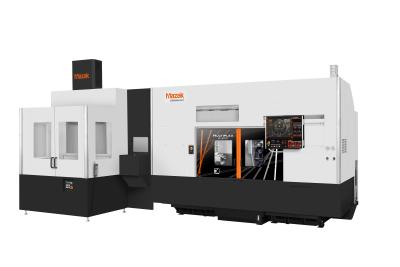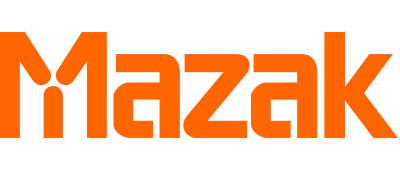
Mazak Corp. offers its Multiplex W-200Y Multi-Tasking CNC turning center, which can be paired with a GL150 gantry loader/unloader for continues part flow. The factory-supplied GL150 gantry loader/unloader provides fast workpiece exchanges to achieve approximately 20% shorter load/unload times thanks to a new rack-and-pinion design that allows for simultaneous motion of doors, chuck confirmations and linear rail motion to reduce overall tack times.
Additionally, a special continuous loop conveyor system – with specifications provided by Mazak’s Automation Group – allows for uninterrupted production. At random intervals, finished parts can also be dropped off on an exit conveyor for full inspection. Designed for single-setup, mid to high-volume production and continuous operations,
the Multiplex W-200Y incorporates dual spindles and dual turrets, as well as milling tools with Y-axis capability. Since both spindles offer identical performance, part processing flexibility is greatly increased, and full 360-degree clamping units are incorporated into the integral spindles to further increase C-axis indexing accuracy.
Both the Multiplex W-200Y’s main and second spindles accommodate 8" chucks and deliver 5,000 rpm and 20 hp of machining speed and power. With a combined 24- tool capacity, the left and right turrets feature 5,000-rpm rotary tool spindles.
For expanded part size versatility, the maximum swing and maximum machining diameter of the Multiplex W-200Y both measure 12.60" (320 mm), while maximum bar capacity is 2.6" (66 mm). A center partition also allows the Multiplex W-200Y to be utilized as two separate machining envelopes should the application require it.
Mazak’s SmoothG CNC, with advanced high-performance functionality, makes programming the Multiplex W-200Y fast and easy. The machine is also MTConnect-ready for convenient networking.
Contact Details
Related Glossary Terms
- chuck
chuck
Workholding device that affixes to a mill, lathe or drill-press spindle. It holds a tool or workpiece by one end, allowing it to be rotated. May also be fitted to the machine table to hold a workpiece. Two or more adjustable jaws actually hold the tool or part. May be actuated manually, pneumatically, hydraulically or electrically. See collet.
- computer numerical control ( CNC)
computer numerical control ( CNC)
Microprocessor-based controller dedicated to a machine tool that permits the creation or modification of parts. Programmed numerical control activates the machine’s servos and spindle drives and controls the various machining operations. See DNC, direct numerical control; NC, numerical control.
- gang cutting ( milling)
gang cutting ( milling)
Machining with several cutters mounted on a single arbor, generally for simultaneous cutting.
- milling
milling
Machining operation in which metal or other material is removed by applying power to a rotating cutter. In vertical milling, the cutting tool is mounted vertically on the spindle. In horizontal milling, the cutting tool is mounted horizontally, either directly on the spindle or on an arbor. Horizontal milling is further broken down into conventional milling, where the cutter rotates opposite the direction of feed, or “up” into the workpiece; and climb milling, where the cutter rotates in the direction of feed, or “down” into the workpiece. Milling operations include plane or surface milling, endmilling, facemilling, angle milling, form milling and profiling.
- turning
turning
Workpiece is held in a chuck, mounted on a face plate or secured between centers and rotated while a cutting tool, normally a single-point tool, is fed into it along its periphery or across its end or face. Takes the form of straight turning (cutting along the periphery of the workpiece); taper turning (creating a taper); step turning (turning different-size diameters on the same work); chamfering (beveling an edge or shoulder); facing (cutting on an end); turning threads (usually external but can be internal); roughing (high-volume metal removal); and finishing (final light cuts). Performed on lathes, turning centers, chucking machines, automatic screw machines and similar machines.

